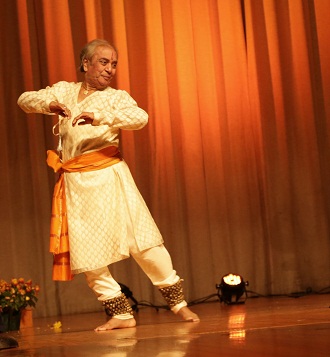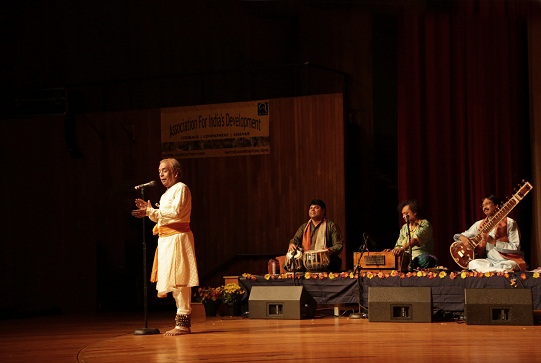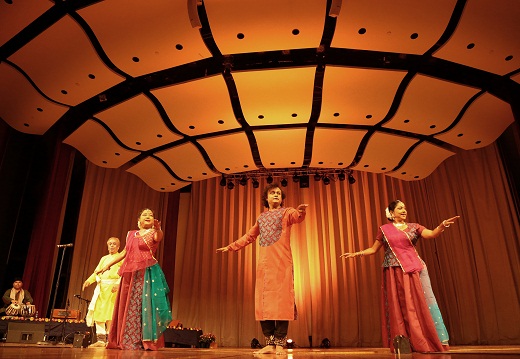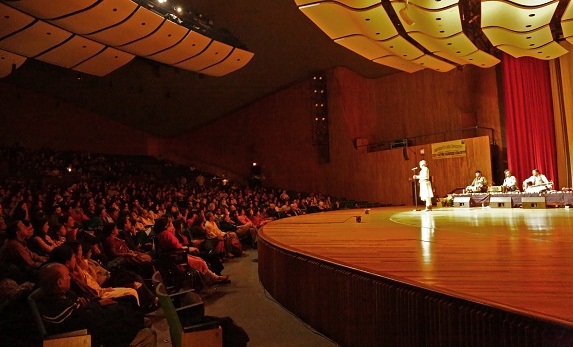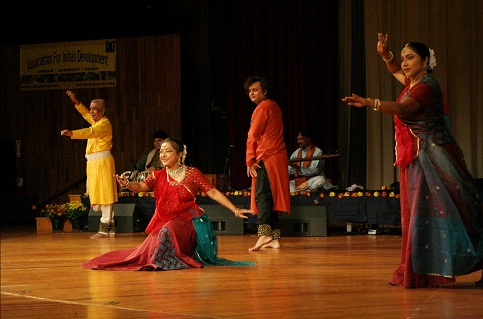Contribute
| Pandit Birju Maharaj Enthralls New England Audiences |
Priya Bangal
10/11/2012
(This article is sponsored by Masala Art)
The legendary Kathak dancer, Pandit Birju Maharaj, and his ensemble performed live in concert at the Kresge Auditorium at MIT on Sunday, October 7. The concert was organized as a fundraiser by the Association for India’s Development (AID) – Boston and MIT chapters and was attended by over 700 people.
A scion of the famous Kalka-Bindadin gharana of Kathak, Maharaj is internationally recognized as a leading exponent of the ancient Indian dance form. Although most recognized for his distinguished talent in Kathak dance, he is also a vocalist, composer, percussionist and a poet par excellence, which was evident from Sunday’s concert. The program began with a soulful rendering of ‘Madhurastakam’, a 16th century Sanskrit poem, performed by Maharaj-ji’s foremost disciple and celebrated dancer, Saswati Sen. Madhurastakam describes the sweetness of Krishna and evokes him as a supreme embodiment of love, beauty and bliss. An impersonation of beauty and grace herself, Sen breathed life into this traditional composition choreographed by Maharaj. This was followed by a duet called ‘Yugal Roop’ performed by Maharaj’s son and disciple, Deepak Maharaj, and Luna Poddar, an accomplished dancer in his ensemble. Composed and choreographed by Pandit Birju Maharaj himself, the theme of this duet was also Krishna – dancing with his consort, Radha, in ecstasy. Krishna’s fancy for the peacock feather in his crown was symbolized through the dance of a peacock in this duet. Dressed in splendid blue costumes in keeping with the theme of the number, Deepak Maharaj and Luna Poddar evoked the duality and oneness of Radha and Krishna - by challenging each other to intricate footwork at times and dancing together to create a soulful harmony of rhythm at others. This vibrant duet filled with sumptuous and sensuous spirituality was perhaps the most unforgettable imagery of the evening.
The highlight of the evening was however, when Pandit Birju Maharaj took to the stage himself. Starting with rhythmic passages of footwork in the time cycle of 16 beats – teental , Maharaj-ji went on to unravel the beauty of rhythm through delicate sounds of ghungroos and rhythmic interplay with the tabla. Engaging the audience in brief conversations between passages of footwork, he explained how rhythm is a part of nature and a part of our lives - beating of our heart, the rising and setting of the sun, the seasons – everything that occurs in a fixed time cycle is rhythmic. Utpal Ghoshal, the accompanying artiste on the tabla, displayed remarkable energy and finesse at the same time. Ghoshal and The Maestro challenging each other to complex crisscross rhythmic patterns before gently arriving on the ‘sum’ (the first beat of the time cycle) had the audience on the edge of their seats. Maharaj then went on to perform a Thumri, another Krishna-themed number portraying his playful mischief with the gopis, or milkmaids. He first recited a few lines of his own poetry on the same theme and then sang the first two lines of the thumri, “mori ghagariya kahe ko phori re shyamâ€, leaving the audience in awe of his boundless talents. His son Deepak Maharaj joined in for vocal accompaniment for the thumri and Chandrachur Bhattacharjee accompanied on the Sitar. The sitar was the only melodic accompaniment in the performance that was otherwise dominated by rhythm and poetry, and it took the immensely talented Bhattacharjee to have it complement or contrast the rhythm as demanded by the compositions. Both Bhattacharjee and Ghoshal displayed a remarkable chemistry with the dancers, which was probably a result of their long and fruitful artistic association with the ensemble. The portrayal of naughty little Krishna stealing butter, by 74-year old Maharaj, was as effortless as his instant transformation into the milkmaid who chides him. Maharaj-ji single-handedly captivated the audience for about an hour with his virtuoso display of rhythmic footwork, musical and poetic talents, nuanced abhinaya and his utterly charming stage presence. He received a standing ovation, marking the first half of the performance before the intermission.
The second half of the performance started with a solo by Saswati Sen, again a rhythmic sequence inspired by the rhythms in everyday life – throwing of a ball, friends calling out to each other and such, demonstrating how Kathak draws from the world around us. Sen then performed a abhinaya number, ‘Ahalya Uddhar’, that told a time-honored tale from the Ramayana. Ahalya, the wife of a sage called Gautama, turns into stone by a curse from her husband and centuries later, is revived to life by the touch of Rama’s feet. The multitude of facial expressions and fine-honed gestures by Ms. Sen portrayed a convincing Ahalya while reminding the audience of the balladeer tradition of Kathak – that it originated to tell stories of the great Indian epics and mythology in the courtyards of ancient Indian temples. This was followed by ‘Layakari’ by Deepak Maharaj, another piece of rhythmic virtuosity in a cycle of 14 beats – taal Dhamaar. The junior Maharaj’s style was characterized by powerful, stamping footwork, vigorous but graceful hand movements in space and a gush of energy that was perhaps, unmatched by anyone else in the troupe. He also gave a splendid display of rhythmic skills, first singing out vocal chants, or bols, corresponding to specific beats, then translating them into eloquent displays of footwork, amplified by the sounds of his ghungroos. The finale of the evening was started by Pandit Birju Maharaj, with the rest of the troupe joining him in a climax of footwork and a playful visual of rhythmic patterns. The magical evening culminated in a standing ovation – the second one of the evening - and both Maharaj and Saswati Sen thanking the Boston audiences for their love and appreciation.
This concert was a result of dedicated efforts by the volunteers of Boston and MIT chapters of the Association for India’s Development (AID). AID is a non-profit organization that works in partnership with various NGOs in India in various interconnected spheres including agriculture, energy, education, health, livelihoods, natural resources, women’s empowerment and social justice. All the proceeds from the concert will go to sustainable developmental projects in grassroots organizations in India. A brief slideshow highlighting AID’s work at the grassroots was shown after the intermission at the concert, which was very well-received by the audience. In a conversation after the concert, Pandit Birju Maharaj and Saswati Sen remarked that working with an organization like AID - that has a vision for just and equitable development and a group of dedicated volunteers to execute it - has been an enriching experience for them. They deeply appreciated the work of the volunteers in organizing the concert and also commended their involvement with AID projects in the grassroots. AID Boston has also organized fundraising concerts of several other reputed artistes such as Pandit Hariprasad Chaurasia, Indian Ocean among others, in the past. AID welcomes volunteers from the community to get involved in their work. AID volunteers meet every Sunday at 2:00 pm at the Harvard Science Center for a Community Service Hour (CSH). To find out more about AID’s work and how you can get involved visit, www.aidboston.org.
You may also access this article through our web-site http://www.lokvani.com/
